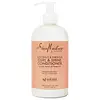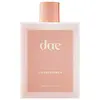What's inside
What's inside
 Key Ingredients
Key Ingredients

 Benefits
Benefits

 Concerns
Concerns

 Ingredients Side-by-side
Ingredients Side-by-side

Water
Skin ConditioningCetearyl Alcohol
EmollientCaprylic/Capric Triglyceride
MaskingCocos Nucifera Oil
MaskingCetyl Alcohol
EmollientStearyl Alcohol
EmollientBehentrimonium Chloride
PreservativeButyrospermum Parkii Butter
Skin ConditioningParfum
MaskingAloe Barbadensis Leaf Juice
Skin ConditioningHydrolyzed Vegetable Protein Pg-Propyl Silanetriol
Skin ConditioningHibiscus Rosa-Sinensis Flower Extract
HumectantSimmondsia Chinensis Seed Oil
EmollientMangifera Indica Seed Butter
Skin ConditioningMelia Azadirachta Seed Oil
EmollientBrassica Campestris Seed Oil
Skin ConditioningPanthenol
Skin ConditioningSodium Lauroyl Hydrolyzed Silk
Skin ConditioningTocopherol
AntioxidantGlycerin
HumectantGlycine Soja Oil
EmollientHydroxyethylcellulose
Emulsion StabilisingTriethyl Citrate
MaskingCaprylyl Glycol
EmollientBenzoic Acid
MaskingWater, Cetearyl Alcohol, Caprylic/Capric Triglyceride, Cocos Nucifera Oil, Cetyl Alcohol, Stearyl Alcohol, Behentrimonium Chloride, Butyrospermum Parkii Butter, Parfum, Aloe Barbadensis Leaf Juice, Hydrolyzed Vegetable Protein Pg-Propyl Silanetriol, Hibiscus Rosa-Sinensis Flower Extract, Simmondsia Chinensis Seed Oil, Mangifera Indica Seed Butter, Melia Azadirachta Seed Oil, Brassica Campestris Seed Oil, Panthenol, Sodium Lauroyl Hydrolyzed Silk, Tocopherol, Glycerin, Glycine Soja Oil, Hydroxyethylcellulose, Triethyl Citrate, Caprylyl Glycol, Benzoic Acid
Water
Skin ConditioningStearyl Alcohol
EmollientBehentrimonium Methosulfate
Cetearyl Alcohol
EmollientCetyl Alcohol
EmollientBetaine
HumectantCyclopentasiloxane
EmollientCetrimonium Chloride
AntimicrobialCitrus Aurantium Dulcis Peel Oil
MaskingParfum
MaskingQuaternium-91
Isopropyl Alcohol
SolventCocos Nucifera Oil
MaskingHydroxypropyl Guar
Emulsion StabilisingPrunus Amygdalus Dulcis Oil
Skin ConditioningVitis Vinifera Seed Oil
EmollientPhenoxyethanol
PreservativeTrimethylsiloxyamodimethicone
Butylene Glycol
HumectantCetrimonium Methosulfate
AntimicrobialHydroxyacetophenone
AntioxidantGlycerin
HumectantCinnamidopropyltrimonium Chloride
Caprylyl Glycol
EmollientGalactoarabinan
C11-15 Pareth-7
EmulsifyingSalvia Hispanica Seed Extract
EmollientChlorphenesin
AntimicrobialEthylhexylglycerin
Skin ConditioningHexylene Glycol
EmulsifyingTrehalose
HumectantXylitol
HumectantButyrospermum Parkii Butter
Skin ConditioningEclipta Prostrata Extract
Skin ConditioningTetrasodium Glutamate Diacetate
Camellia Sinensis Leaf Extract
AntimicrobialPanthenol
Skin ConditioningC12-16 Pareth-9
EmulsifyingTrideceth-12
EmulsifyingSodium Phosphate
BufferingMelia Azadirachta Leaf Extract
Skin ConditioningTocopherol
AntioxidantMoringa Oleifera Leaf Extract
Skin ConditioningMoringa Oleifera Seed Oil
EmollientCereus Grandiflorus Extract
AntioxidantCitrus Aurantifolia Fruit Extract
Skin ConditioningHibiscus Rosa-Sinensis Flower Extract
HumectantPhalaenopsis Amabilis Flower Extract
BleachingAloe Barbadensis Leaf Juice
Skin ConditioningWater, Stearyl Alcohol, Behentrimonium Methosulfate, Cetearyl Alcohol, Cetyl Alcohol, Betaine, Cyclopentasiloxane, Cetrimonium Chloride, Citrus Aurantium Dulcis Peel Oil, Parfum, Quaternium-91, Isopropyl Alcohol, Cocos Nucifera Oil, Hydroxypropyl Guar, Prunus Amygdalus Dulcis Oil, Vitis Vinifera Seed Oil, Phenoxyethanol, Trimethylsiloxyamodimethicone, Butylene Glycol, Cetrimonium Methosulfate, Hydroxyacetophenone, Glycerin, Cinnamidopropyltrimonium Chloride, Caprylyl Glycol, Galactoarabinan, C11-15 Pareth-7, Salvia Hispanica Seed Extract, Chlorphenesin, Ethylhexylglycerin, Hexylene Glycol, Trehalose, Xylitol, Butyrospermum Parkii Butter, Eclipta Prostrata Extract, Tetrasodium Glutamate Diacetate, Camellia Sinensis Leaf Extract, Panthenol, C12-16 Pareth-9, Trideceth-12, Sodium Phosphate, Melia Azadirachta Leaf Extract, Tocopherol, Moringa Oleifera Leaf Extract, Moringa Oleifera Seed Oil, Cereus Grandiflorus Extract, Citrus Aurantifolia Fruit Extract, Hibiscus Rosa-Sinensis Flower Extract, Phalaenopsis Amabilis Flower Extract, Aloe Barbadensis Leaf Juice
Ingredients Explained
These ingredients are found in both products.
Ingredients higher up in an ingredient list are typically present in a larger amount.
Aloe Barbadensis Leaf Juice comes from leaves of the aloe plant. Aloe Barbadensis Leaf Juice is best known for helping to soothe sunburns. It is also anti-inflammatory, moisturizing, antiseptic, and can help heal wounds.
Aloe is packed with good stuff including Vitamins A, C, and E. These vitamins are antioxidants, which help fight free-radicals and the damage they may cause. Free-radicals are molecules that may damage your skin cells, such as pollution.
Aloe Barbadensis Leaf Juice also contains sugars. These sugars come in the form of monosaccharides and polysaccharides, folic acid, and choline. These sugars are able to help bind moisture to skin.
It also contains minerals such as calcium, 12 anthraquinones, fatty acids, amino acids, and Vitamin B12.
Learn more about Aloe Barbadensis Leaf JuiceThis ingredient is also known as shea butter. It is an effective skin hydrator and emollient.
Emollients help soothe and soften your skin. It does this by creating a protective film on your skin. This barrier helps trap moisture and keeps your skin hydrated. Emollients may be effective at treating dry or itchy skin.
Shea butter is rich in antioxidants. Antioxidants help fight free-radicals, or molecules that may harm the body. It is also full of fatty acids including stearic acid and linoleic acid. These acids help replenish the skin and keep skin moisturized.
While Shea Butter has an SPF rating of about 3-4, it is not a sunscreen replacement.
Shea butter may not be fungal acne safe. We recommend speaking with a professional if you have any concerns.
Learn more about Butyrospermum Parkii ButterCaprylyl Glycol is a humectant and emollient, meaning it attracts and preserves moisture.
It is a common ingredient in many products, especially those designed to hydrate skin. The primary benefits are retaining moisture, skin softening, and promoting a healthy skin barrier.
Though Caprylyl Glycol is an alcohol derived from fatty acids, it is not the kind that can dry out skin.
This ingredient is also used as a preservative to extend the life of products. It has slight antimicrobial properties.
Learn more about Caprylyl GlycolCetearyl alcohol is a mixture of two fatty alcohols: cetyl alcohol and stearyl alcohol. It is mainly used as an emulsifier. Emulsifiers help prevent the separation of oils and products. Due to its composition, it can also be used to thicken a product or help create foam.
Cetearyl alcohol is an emollient. Emollients help soothe and hydrate the skin by trapping moisture.
Studies show Cetearyl alcohol is non-toxic and non-irritating. The FDA allows products labeled "alcohol-free" to have fatty alcohols.
This ingredient is usually derived from plant oils such as palm, vegetable, or coconut oils. There is debate on whether this ingredient will cause acne.
Due to the fatty acid base, this ingredient may not be Malassezia folliculitis safe.
Learn more about Cetearyl AlcoholCetyl Alcohol is a fatty alcohol. Fatty Alcohols are most often used as an emollient or to thicken a product.
Its main roles are:
Though it has "alcohol" in the name, it is not related to denatured alcohol or ethyl alcohol.
The FDA allows products labeled "alcohol-free" to have fatty alcohols.
Learn more about Cetyl AlcoholCocos Nucifera Oil is obtained from the kernels of the coconut fruit. In other words, this is coconut oil.
Coconut Oil is rich in fatty acids with lauric acid making up the majority of these. It also contains linoleic acid. Due to this high fatty acid content, coconut oil helps trap moisture and soften skin.
Despite being antibacterial, coconut oil may not be great for acne-prone skin. It is comedogenic and may clog pores. This ingredient may not be safe for malassezia or fungal acne.
Note: Coconut Oil should not replace your sunscreen for UV protection. Studies show it only blocks about 20% of UV.
This oil is non-volatile and has a light scent.
The term 'fragrance' is not regulated in many countries. In many cases, it is up to the brand to define this term. For instance, many brands choose to label themselves as "fragrance-free" because they are not using synthetic fragrances. However, their products may still contain ingredients such as essential oils that are considered a fragrance.
Learn more about Cocos Nucifera OilGlycerin is already naturally found in your skin. It helps moisturize and protect your skin.
A study from 2016 found glycerin to be more effective as a humectant than AHAs and hyaluronic acid.
As a humectant, it helps the skin stay hydrated by pulling moisture to your skin. The low molecular weight of glycerin allows it to pull moisture into the deeper layers of your skin.
Hydrated skin improves your skin barrier; Your skin barrier helps protect against irritants and bacteria.
Glycerin has also been found to have antimicrobial and antiviral properties. Due to these properties, glycerin is often used in wound and burn treatments.
In cosmetics, glycerin is usually derived from plants such as soybean or palm. However, it can also be sourced from animals, such as tallow or animal fat.
This ingredient is organic, colorless, odorless, and non-toxic.
Glycerin is the name for this ingredient in American English. British English uses Glycerol/Glycerine.
Learn more about GlycerinWe don't have a description for Hibiscus Rosa-Sinensis Flower Extract yet.
Panthenol is a common ingredient that helps hydrate and soothe the skin. It is found naturally in our skin and hair.
There are two forms of panthenol: D and L.
D-panthenol is also known as dexpanthenol. Most cosmetics use dexpanthenol or a mixture of D and L-panthenol.
Panthenol is famous due to its ability to go deeper into the skin's layers. Using this ingredient has numerous pros (and no cons):
Like hyaluronic acid, panthenol is a humectant. Humectants are able to bind and hold large amounts of water to keep skin hydrated.
This ingredient works well for wound healing. It works by increasing tissue in the wound and helps close open wounds.
Once oxidized, panthenol converts to pantothenic acid. Panthothenic acid is found in all living cells.
This ingredient is also referred to as pro-vitamin B5.
Learn more about PanthenolParfum is a catch-all term for an ingredient or more that is used to give a scent to products.
Also called "fragrance", this ingredient can be a blend of hundreds of chemicals or plant oils. This means every product with "fragrance" or "parfum" in the ingredients list is a different mixture.
For instance, Habanolide is a proprietary trade name for a specific aroma chemical. When used as a fragrance ingredient in cosmetics, most aroma chemicals fall under the broad labeling category of “FRAGRANCE” or “PARFUM” according to EU and US regulations.
The term 'parfum' or 'fragrance' is not regulated in many countries. In many cases, it is up to the brand to define this term.
For instance, many brands choose to label themselves as "fragrance-free" because they are not using synthetic fragrances. However, their products may still contain ingredients such as essential oils that are considered a fragrance by INCI standards.
One example is Calendula flower extract. Calendula is an essential oil that still imparts a scent or 'fragrance'.
Depending on the blend, the ingredients in the mixture can cause allergies and sensitivities on the skin. Some ingredients that are known EU allergens include linalool and citronellol.
Parfum can also be used to mask or cover an unpleasant scent.
The bottom line is: not all fragrances/parfum/ingredients are created equally. If you are worried about fragrances, we recommend taking a closer look at an ingredient. And of course, we always recommend speaking with a professional.
Learn more about ParfumStearyl Alcohol is a type of fatty alcohol from stearic acid. It is a white, waxy compound used to emulsify ingredients.
Fatty Alcohols are most often used as an emollient or to thicken a product. Emollients help soothe and hydrate the skin by trapping moisture.
They are usually derived from natural fats and oils and therefore do not have the same drying or irritating effect as solvent alcohols. FDA allows products labeled "alcohol-free" to have fatty alcohols.
Learn more about Stearyl AlcoholTocopherol (also known as Vitamin E) is a common antioxidant used to help protect the skin from free-radicals and strengthen the skin barrier. It's also fat soluble - this means our skin is great at absorbing it.
Vitamin E also helps keep your natural skin lipids healthy. Your lipid skin barrier naturally consists of lipids, ceramides, and fatty acids. Vitamin E offers extra protection for your skin’s lipid barrier, keeping your skin healthy and nourished.
Another benefit is a bit of UV protection. Vitamin E helps reduce the damage caused by UVB rays. (It should not replace your sunscreen). Combining it with Vitamin C can decrease sunburned cells and hyperpigmentation after UV exposure.
You might have noticed Vitamin E + C often paired together. This is because it is great at stabilizing Vitamin C. Using the two together helps increase the effectiveness of both ingredients.
There are often claims that Vitamin E can reduce/prevent scarring, but these claims haven't been confirmed by scientific research.
Learn more about TocopherolWater. It's the most common cosmetic ingredient of all. You'll usually see it at the top of ingredient lists, meaning that it makes up the largest part of the product.
So why is it so popular? Water most often acts as a solvent - this means that it helps dissolve other ingredients into the formulation.
You'll also recognize water as that liquid we all need to stay alive. If you see this, drink a glass of water. Stay hydrated!
Learn more about Water